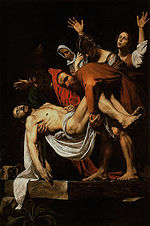| Part of a series on |
| Death and Resurrection of Jesus |
|---|
 |
|
Portals: |
The vision theory or vision hypothesis is a term used to cover a range of theories that question the physical resurrection of Jesus, and suggest that sightings of a risen Jesus were visionary experiences, often classified as grief or bereavement visions. It was first formulated by David Friedrich Strauss in the 19th century, and has been proposed in several forms by critical contemporary scholarship, including Helmut Koester,[1] Géza Vermes,[2] and Larry Hurtado,[3] and members of the Jesus Seminar such as Gerd Lüdemann.[4]
Christian apologists, scholars, and theologians reject the theory, holding the resurrection to be an actual bodily phenomenon.[5][6][7][8]
- ^ Koester 2000, p. 64-65.
- ^ Vermes 2008a, p. 151–152.
- ^ Hurtado 2005, p. 73.
- ^ Kubitza 2016.
- ^ "Habermas". Archived from the original on 2003-02-07. Retrieved 2005-08-26.
- ^ Cite error: The named reference
Craigwas invoked but never defined (see the help page). - ^ Michael Morrison The Resurrection of Jesus: A History of Interpretation Archived 2015-03-29 at the Wayback Machine
- ^ Bergeron & Habermas 2015.
